Poseidon: Greek God of the Sea Who Created the Minotaur
Remembered today as the God of the Sea, Poseidon is one of the most well-known Greek gods. Whilst he is immortalized in myths as a violent and hot-headed god who would brew up a raging sea, the story of his life remains an entertaining one. Beginning with being swallowed by his own father and saved by his younger brother Zeus, like most of the Classical Gods, Poseidon’s life was not simple, and it was not easy.
The Mythological Origins of Poseidon
Myths about Poseidon date back as far as the late Bronze Age and the Mycenaean civilization (1750-1050 BC) in Greece. Evidence for this has been located in the Linear B inscriptions discovered at Pylos in the Peloponnese region and the Knossos archaeological site on Crete.
The Linear B script was a writing system used by the Mycenaean population most likely between 1450 and 1100 BC. These inscriptions are some of the oldest preserved forms of written Greek that we know of. The Linear B tablets discovered in Knossos are named the “Room of the Chariot Tablets,” which were made between 1450-1350 BC. Those found at Pylos were dated 1200 BC.
- The Three Distinct Scripts of Knossos: An Unfinished Epic
- Knossos Thrived Well into the Iron Age and Was Much Larger than Once Believed
When Michael Ventris, an English architect, classicist and philologist, translated the tablets in 1953, he discovered that they were mostly of an administrative nature, generally containing lists of goods, records of deliveries, and commercial transactions. Because the Mycenaean palaces, where these tablets would have been used, were not only economic and political hubs but religious hubs too, some Linear B tablets contain lists of religious offerings.
Not only do these lists provide us with examples of what kind of goods were offered to the Gods, but they also tell us who these gods were. Many of these gods shared names with the deities from classical Greece: Hera, Hermes, Zeus, Ares, Dionysos, Artemis and most importantly, Poseidon. This discovery, therefore, implies that Poseidon was an important deity in the Mycenaean culture and given their seafaring skills, this is not surprising.
The meaning of Poseidon’s name is unfortunately lost to time. Various authors have attempted to translate it. Some argue it translates to “husband of the earth” or “lord of the waters.” Plato concludes it means “knower of many things,” but this seems unlikely as it does not relate to Poseidon's other epitaphs or his role as a god.
He has had many epitaphs throughout history. Some ancients referred to him as the “Savior of Sailors,” others referred to him as the “Averter of Earthquakes.” Some tie him to his horses and know him as “The Creator and Tamer of Horses.” Some, seemingly randomly, refer to him as “The Leader of the Nymphs.”
Whilst today Poseidon is known as the God of the Sea, in ancient times he seems to have a broader reputation. He is sometimes related to the Earth and fertility. He is even sometimes referred to as the God of the Sky and almost looks like Zeus. This is not surprising however, given that they were brothers.
Poseidon often appears as a bearded man with a lot of curly hair and piercing eyes. He is often shown to be riding a four-horse chariot and holding his famous trident as he travels the waves. The trident is also carried by his son Triton.
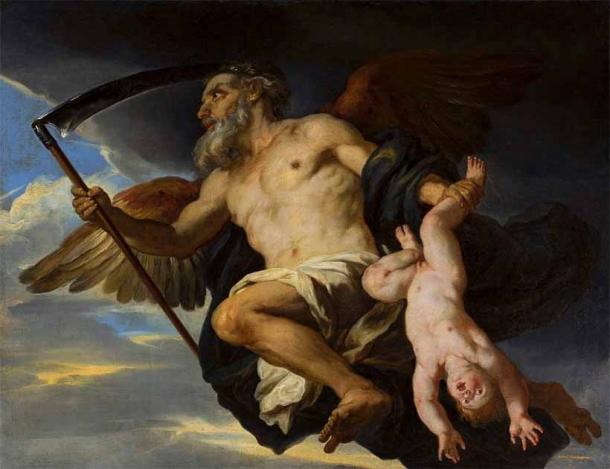
Kronos (Chronos) and his child, which could be his son Poseidon, by Giovanni Francesco Romanelli, a 17th-century depiction of the Titan Cronus as "Father Time," wielding a harvesting scythe. (Giovanni Francesco Romanelli / Public domain)
The “Family Life” of Poseidon, Son of Kronos and Rhea
We have a clearer picture of Poseidon and his life from later Greek mythology. Here he is the son of Kronos (or Chronos) and Rhea and the brother of Hades and Zeus. Poseidon was the middle child; Hades was his older brother, and Zeus was his younger brother. His sisters were Hestia, Demeter, and Hera.
One of the first myths about his life is that, like his other siblings (excluding Zeus), he was swallowed by his father Kronos. Kronos had decided it was necessary to swallow his offspring because a prophecy had stated that his children would someday overthrow him. However, thanks to his younger brother Zeus, Poseidon was disgorged and survived.
Other myths do not include this traumatic event in Poseidon’s early life, however, and instead state that Rhea, his mother, managed to hide the young Poseidon from his father. These reports state that Rhea managed to hide her son in either a flock of lambs in Arcadia or in Rhodes where he would be raised by Oceanus’ daughter Capheria and the Telchines.
Poseidon became the God of the Sea after the battles for control over the universe between the Titans, the Giants and the Olympians. Poseidon, Zeus, and Hades were victorious and as part of their reward, they drew lots to decide who would rule over which domain. Poseidon won the sea, Zeus the sky, and Hades the underworld.
Poseidon made his home under the sea. It is said that he built a magnificent golden palace under the waves that was adorned with coral and sea flowers. Attached to his mighty palace were his stables where he kept his fine white horses. It is traditionally told that this palace was located near Aegae in Euboea, the second largest island in Greece after Crete.
However, Poseidon soon grew unhappy with his position and with the help of the goddesses, Hera and Athena attempted to overthrow his brother, Zeus. Poseidon became known for his violent character; he is said to have been impulsive and hot-blooded. It was perhaps because of this that he decided he could not put up with Zeus’ arrogant behavior anymore. Unfortunately for him, Poseidon failed when Zeus, who had sought the help of Thetis and Briareus, won.
As punishment Zeus sent his older brother, accompanied by Apollo to serve the Trojan king Laomedon. Whilst under Laomedon’s rule, the pair built the magnificent walls surrounding the city of Troy. But when the time came for payment, Laomedon refused to pay for their labor. Against the advice of Zeus, Poseidon fought on the Greek side during the Trojan War and even sent a sea monster (Cetus) to attack and torment the Trojans.
Poseidon found further conflict when he became entangled in a contest for Athens with Athena. It is said that the two were in competition to win the patronage of the city. Poseidon offered the city the gift of a seawater spring and a horse. Athena offered an olive tree. The latter won the favor of the city, and she was made patron. As a runner-up, Poseidon was honored with his name being attributed to the annual Posideai festival.
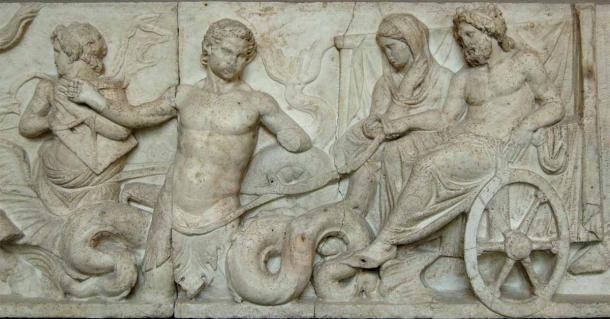
A Roman 2nd-century bas-relief sea thiasos grouping depicting the wedding of Poseidon and Nereid Amphitrite, from the Altar of Domitius Ahenobarbus in the Field of Mars. (Glyptothek / Public domain)
Poseidon Had Many Lovers And Then Married Amphitrite
It seems that Poseidon had a number of lovers and a large number of children. His wife was the Nereid Amphitrite. She provided some difficulty for Poseidon whilst they were dating and there is one tale that reports she once fled to the Atlas Mountains. To get her back Poseidon sought the help of the dolphin Delphius who was able to persuade Amphitrite to return and marry the sea god. To thank the dolphin for its help, Poseidon ensured that a constellation that looked like her was made.
Poseidon’s children with Amphitrite were Triton, Rhode, and Benthesicyme. The most famous is perhaps the former who was half-man and half-fish. In addition to these children, as mentioned above, Poseidon had a great number of offspring with other divinities.
Poseidon fathered Theseus with Aithra, Polyphemus the Cyclops with Thoosa, Orion the Hunter with the daughter of Minos, the flying horse Pegasus from his rape of Medusa, and the wild horse Arion and Charybdis the ship-eating sea monster with Gia.
However, Amphitrite did not put up with this behavior. Whilst Poseidon was infatuated with Scylla, the daughter of the sea god Phorcys, Amphitrite decided to take action. She cast magic herbs in her husband’s lovers' bath which transformed her into a monster with 12 feet and six heads! She joined Charybdis (one of Poseidon’s children) and terrorized mariners who travelled through the Straits of Messina located between Sicily and mainland Italy.
Poseidon was not only responsible for the creation of these sea monsters. He was also responsible of the Minotaur. When Minos failed to sacrifice a bull given as a gift by Poseidon, the latter bewitched Minos’ wife Pasiphae into falling in love with the animal. She ended up pregnant and gave birth to a half-man, half-bull that went on to inhabit the labyrinth of Knossos.
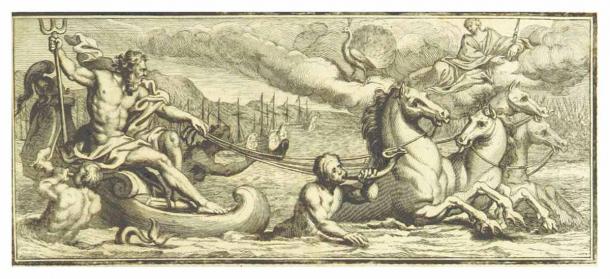
In Homer’s Iliad Poseidon plays a powerful role in the epic Greek battle of Troy. (British Library / Public domain)
The Trojan War Hero Poseidon in Homer’s Illiad
Poseidon features heavily in Homer’s epic poem The Iliad. Written around the 8th century BC, it is one of the oldest works of Western literature that still exists today. Its author, Homer, is often regarded as one of the most influential authors of all time. The poem is set during the Trojan War and chronicles the 10-year siege of the city of Troy by the Mycenaean Greek kingdoms.
In Homer’s tale, during this war, Poseidon supports the Greeks and provides them with inspirational speeches in the disguise of various Achaean (Greek) individuals. At some points he even leads them in battle. He does not provide this aid to the Trojans and does not help Aeneas escape Achilles.
Another influential work of Homer’s that Poseidon features in is the Odyssey. This epic poem follows the Greek hero Odysseus who was King of Ithaca and his journey home after the Trojan War. In this tale, Poseidon curses Odysseus to wander the sea for 10 years after he blinded Poseidon’s son Polyphemus.
Another Greek poet who was writing in the 8th century and mentioned Poseidon was Hesiod. His work Theogony describes the origins and genealogy of the gods. He describes Poseidon as “the earth-holder who shakes the earth.”
Both Homer and Hesiod describe Poseidon as the “deep sounding Earth-shaker,” and the “dark-haired-one.” They also refer to him as the “encircler of the earth,” which is illustrative of the fact that those in ancient times often believed that all waterways on Earth were connected and that land simply floated on top of them.
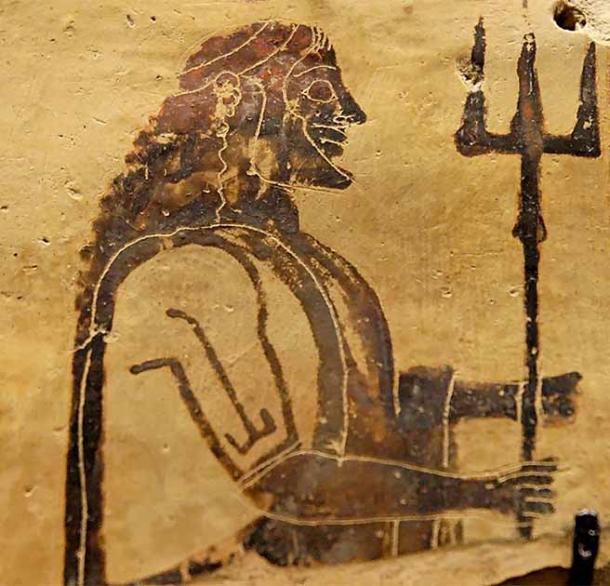
For many centuries Poseidon (and the Roman Neptune) was worshipped by sailors and maritime fishermen as evidenced by clay plaques like this one from the Archaic period found at Corinth. (The Louvre / CC BY 2.0)
The Worship of Poseidon
Poseidon is often associated with the ancient city of Corinth. It is said that he held the Isthmus of Corinth close to his heart, probably because it was an important sea route. The God of the Sea was also celebrated here. There was a focus on horse races in the Panhellenic Isthmian games which were held in Poseidon's honor near Corinth.
Much like the Olympic Games, the Corinth games were held every two years. Athletes, charioteers and horse races competed to win. Here the prize was originally a crown of pine and then later in the Classical period, a crown of dry celery.
- The Realm of Poseidon: A Mythical Voyage Around the Aegean
- Neptune: The Evolving Roman God Of Fresh Water, The Sea and Horses
According to Cartwright, Corinth is also one of the earliest cities to connect Poseidon to maritime trade and navigation as implied by clay plaques found there dating to the Archaic period.
Another strategic site connected to the God of the Sea was Sounion, 69.5 km (43.1 miles) southeast of Athens in East Attica, Greece, where a 5th-century temple in his honor still stands overlooking the ships entering the Saronic Gulf. Here Poseidon was honored by boat races once every four years.
To conclude, Poseidon, like many of the classical gods is an interesting figure. His life was in no way simple, which is perhaps what makes it so interesting for us today. His integration into the most influential poems of the day depicts his importance to the Ancient Greeks and their culture in good times and bad.
Top image: An ancient statue of Poseidon, the mighty Greek God of the Sea, against blue sky background. Source: zwiebackesser / Adobe Stock
By Molly Dowdeswell
References
Cartwright, Mark. 2019. Poseidon. Available at https://www.worldhistory.org/poseidon/
Kapach, Avi. 2022. Poseidon. Available at https://mythopedia.com/topics/poseidon#note-1
Poseidon: Greek God of the Sea. Available at https://www.greekmythology.com/Olympians/Poseidon/poseidon.html


















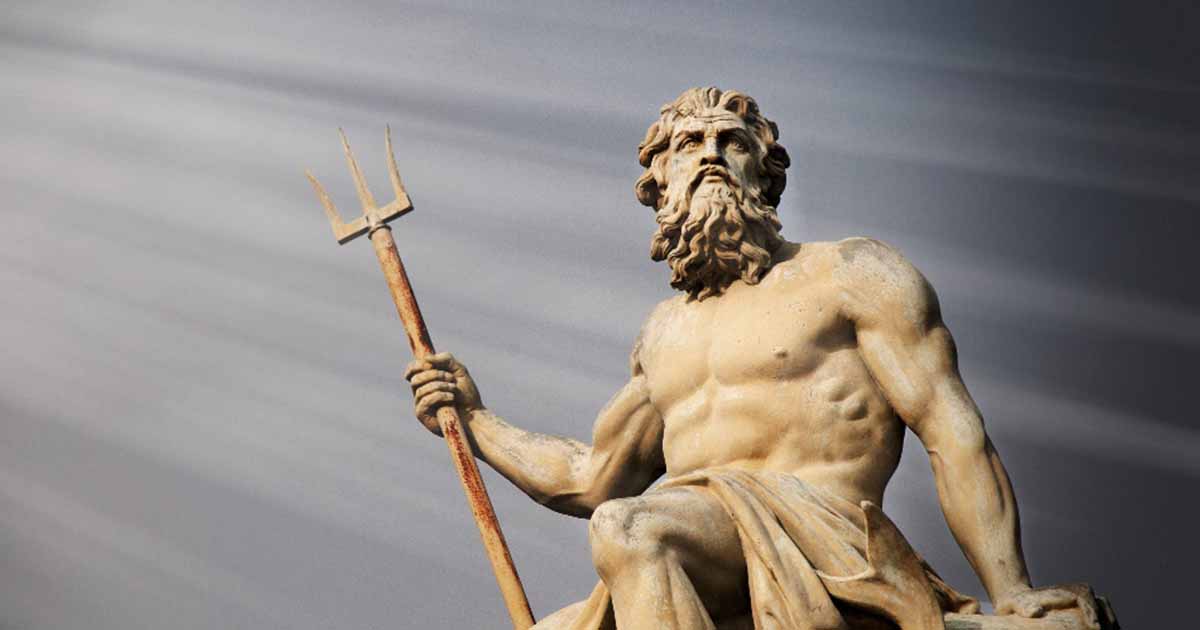

Comments
Poseidon = Neptune, ruler of all liquids and the deceiver.
Symbolic,down,describe
infinitesimal waveparticles comprise what we call home the earth
manipulatable by thought ability supressed in humans since birth
More evidence of what ive said before.. that dieties from cultures all over could be the exact same.. in this case tied back to ea.. and as for sumbolic significances i have no answer... But the possibility exists that these stories are passed fown distorted truths.. then it may very well be a high technological artefact with a multitude of uses that LOOKED like a trident... Another example of this would be the one eyed femorian from celtic myth... Sounds very much like some form of high energy laser... Vimanas being the no different from the celestial chariots of sumerian, etc.. Again so much time has passed since that distortion is inevitable, and a dumbed down race of slaves wouldnt very well be able to desribe much beyond shape and effect..
infinitesimal waveparticles comprise what we call home the earth
manipulatable by thought ability supressed in humans since birth
Hi All,
I've got about so far name's of 4 Sea Deities Dagon, Neptune, Poseidon, Triton yet I've become aware of a Sea Deity in India the thing that I'm noticing well accept for Dagon deity worshipped by The Phonecians and Canaanites they all carry The Trident what is the significance of the Trident?
Can anyone tell me?
This I'd call I've wish to share in this discussion so until the next discussion over which intriguing Subject and Topic here at Ancient Origins Everyone Goodbye!